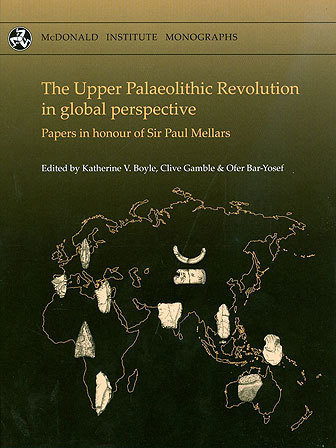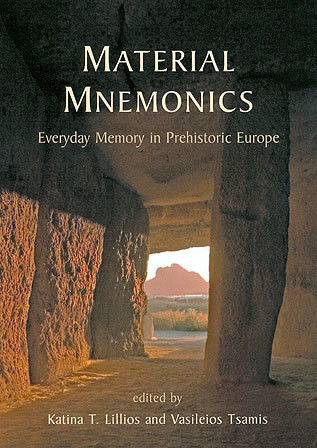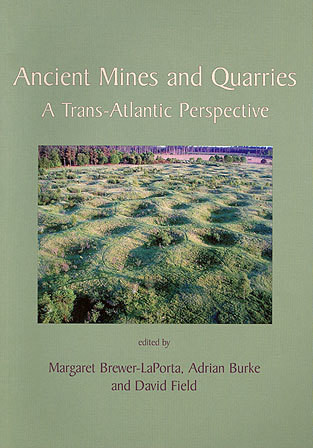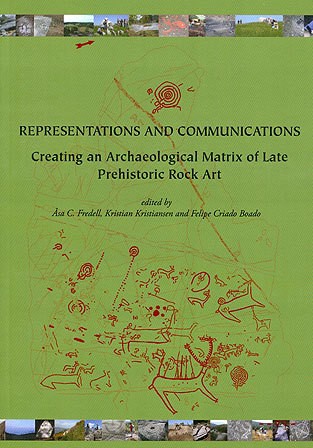
Format: Hardback
Pages: 177
ISBN: 9781902937533
Pub Date: 29 Nov 2010
Illustrations: b/w illus
Description:
The Palaeolithic is the only period in archaeology that can be studied globally. In the last half century one prehistorian, Sir Paul Mellars, has changed the shape and direction of such studies, adding immeasurably to what we know about humanity's earliest origins and the timing of crucial transitions in the journey. The Upper Palaeolithic Revolution in global perspective is a collection of essays in his honour.
Contributions cover both his own area of primary interest (Franco-Cantabria) as well as many other regions of the world, all of which he has considered while writing about the Human Revolution in its wider geographical context. Papers in this volume examine the archaeological record of the Upper Pleistocene from Australia, through eastern and western Asia and Africa to northern Spain and the classical Périgord region of France, a cornerstone region which Mellars has been researching and publishing on since 1965. To papers on chronology, typology, subsistence and social complexity are added historical and theoretical contributions, along with a biography. These illustrate not only Paul Mellars's impact on the current shape and direction of Palaeolithic studies but also how the subject has changed and continues to change.

Format: Hardback
Pages: 210
ISBN: 9781898249245
Pub Date: 15 Nov 2010
Description:
This volume, the third in the series of reports on the excavations carried out at the Canhasan I mound in south-central Anatolia in the years 1961-1968, follows the publication of the stratification and structures (Canhasan Sites 1) and of the pottery (Canhasan Sites 2). Here, the primary aim is to present a descriptive account and catalogue of the registered small-finds. The small-finds have been grouped, described and then illustrated according to material, e.
g., clay, stone, bone. The separation into discrete groups and the description of individual objects have both been deliberately simplified, the intention being to provide (where possible chronologically) an orderly arrangement from which those interested are able to scan and note the range of materials and, if they wish, to take up relevant aspects or indeed to inspect the objects for further study and research. The location of the site at Canhasan is set unequivocally between East and West, close to, if not on, a major land route from the Near East to the Aegean and to Europe. Inevitably, in this geographical context, some materials, such as obsidian and copper, will catch the eye. These have a utilitarian purpose and introduce the factor of distance between source and Canhasan. One object, however, - an ivory bracelet - not only emphasises, by its presence at Canhasan, the distant source of the material but points directly to the nature and dynamics of trade/transfer/exchange in the 6th millennium. The bracelet documents the role of personal display and human vanity as an incentive for material acquisition.

Format: Paperback
Pages: 192
ISBN: 9781842179666
Pub Date: 12 Sep 2010
Illustrations: b/w illus
Description:
How did ancient Europeans materialise memory? Material Mnemonics: Everyday Practices in Prehistoric Europe provides a fresh approach to the archaeological study of memory. Drawing on case studies from the British Isles, Scandinavia, central Europe, Greece, Italy and the Iberian Peninsula that date from the Neolithic through the Iron Age, the book's authors explore the implications of our understanding of the past when memory and mnemonic practices are placed in the center of cultural analyses.
They discuss monument building, personal adornment, relic-making, mortuary rituals, the burning of bodies and houses and the maintenance of domestic spaces and structures over long periods of time. Material Mnemonics engages with contemporary debates on the intersection of memory, identity, embodiment, and power and challenges archaeologists to consider how materiality both provokes and constrains the mnemonic processes in everyday life.

Format: Paperback
Pages: 286
ISBN: 9789088900433
Pub Date: 24 Aug 2010
Illustrations: col illus throughout
Description:
Flint was the primary raw material used for tools until c. 4000 years ago. Its properties allow the production of very sharp edges, which made it essential in many activities related to craft and subsistence.
The fact that flint tools have been used for a long period of time almost everywhere in the world makes them an important source of information in the study of prehistory. Several general questions about this material are of interest to archaeologists: where was the raw material obtained? How can we distinguish between man-made artefacts and natural pieces of flint? What techniques can be used to work flint, and how can we recognise them? How were the different tools used in an effective way? This book tries to answer all of these questions by describing the subsequent stages: acquisition of raw material, flint knapping techniques, recognition of pseudo-artefacts and geofacts, typology of common tool types found in northwestern Europe and discussion of the most effective way to use these tools. The book is richly illustrated with full colour figures. Text in Dutch.

Format: Paperback
Pages: 256
ISBN: 9781842174043
Pub Date: 10 Jul 2010
Series: Neolithic Studies Group Seminar Papers
Illustrations: 101 b/w illus, 13 colour illus, 5 tables
Description:
This volume, the tenth published collection of seminar papers from the Neolithic Studies Group, is based upon a conference that took place at the British Museum in November 2008. The meeting aimed to consider the chronology and development of Neolithic round mounds; their changing form and use; their relationships to contemporary cultural, ancestral and natural landscapes; the extent to which they provide scope for identifying local and regional social organization; and, not least, why they were round. Following the conference, further papers were offered for this edited volume, widening and broadening the initial discussion.
The papers are arranged in rough geographic order starting in the north and working southwards before heading across the Irish Sea and then the Atlantic. Following a wide-ranging discussion of round mounds across the world, two papers discuss aspects of Scottish round mounds, before moving down to the Isle of Man, the Neolithic round mounds of the Yorkshire Wolds, Liffs Low in the Derbyshire Peak District, and round mounds on the Cotswolds. The volume then moves to Wessex, starting with a discussion of Silbury Hill, and followed by a re-evaluation of the Great Barrow at Knowlton, Conquer Barrow at Mount Pleasant, and the Hatfield Barrow at Marden. How archaeologists and heritage managers choose to interpret round mounds is the subject of the next paper, using Silbury Hill as the primary case study. This is followed by a broad discussion of circular traditions, particularly formative henges, in Wales and adjacent counties, round burial mounds in the Boyne Valley, Ireland, such as Knowth, Dowth and Newgrange, and Irish round mounds containing portal tombs. By way of comparison with the evidence from the British Isles, the volume then crosses over to North America for a broad discussion of mound-building traditions there. Rounding off the volume is another wide-ranging essay on the nature of round mounds, which challenges our very understanding and interpretation of them.

Format: Paperback
Pages: 272
ISBN: 9781842174050
Pub Date: 30 Jun 2010
Illustrations: 159 b/w & colour illus, 2 tables
Description:
This volume derives from a workshop held at the University of Kalmar (now Linnaeus University), Sweden between the 20-24 of October 2008. The aim of this gathering was to provide a forum for rock art researchers from different parts of northern Europe to discuss traditional as well as current interpretative trends within rock art research. Changing Pictures aims to return to traditional interpretative notions regarding the meaning and significance of rock art to investigate if and why any information had been left behind to recover and rethink.
During the last decades, there has been an immense global interest among archaeologists and anthropologists in studying rock art. Research in northern Europe, as elsewhere, has intensely explored a manifold of methodological and theoretical perspectives. Most of these studies however, have been published in languages that seldom reach beyond the native speakers of Norwegian, Danish, and Swedish, Russian or Finnish. Therefore an important motivation for this volume is to try to apprise some of the current movements within this field of research and present it for an international audience. These papers explore the relevance of older ideas, such as notions about prehistoric religion, ritual performance, sympathetic magic, animism and totemism, the mindscapes of landscapes etc., as well as the present "state of the art" in order to develop a broader understanding of the phenomenon we call rock art. This aspiration can be seen as a common thread linking the different chapters in this book. Saying that, some, if not all, of the articles presented in this volume challenge the notion "rock art" itself, arguing that sometimes the rock, the "canvas" and rather intangible but equally important sensual encounters, such as sound, echoes, touch and temporal phenomenological changes and the perception of decorated rock art panels, should be regarded, at least, as important as the "art" itself. By reassessing traditional approaches to Scandinavian rock art and creatively reworking these ideas, whilst also addressing significant new concepts such as the agency of rock and the performativity of rock art, this anthology of papers offers not only a snapshot of current debates, but also reflects pivotal changes in the study of rock art.

Format: Paperback
Pages: 512
ISBN: 9789088900396
Pub Date: 30 Apr 2010
Description:
Central Javanese temples were not built anywhere and anyhow. On the contrary: their positions within the landscape and their architectural designs were determined by socio-cultural, religious and economic factors. This book explores the correlations between temple distribution, natural surroundings and architectural design to understand how Central Javanese people structured the space around them, and how the religious landscape thus created, developed.
Besides questions related to territory and landscape, Degroot's book analyzes the structure of the built space and its possible relations with conceptualized space, showing the influence of imported Indian concepts, as well as their limits. Going off the beaten track, this book explores the hundreds of small sites that scatter the landscape of Central Java. It is also one of very few studies to apply the methods of spatial archaeology to Central Javanese temples and the first in almost a century to present a descriptive inventory of the remains of this region.

Format: Hardback
Pages: 250
ISBN: 9781905905157
Pub Date: 06 Apr 2010
Series: Oxford University School of Archaeology Monograph
Description:
The Najerilla flows from the mountains of the Sierra de la Demanda to the River Ebro in the western part of the province of La Rioja in northern Spain. Here fieldwork and excavations from 2000-2003 examined the varied landscapes of the valley and focused on the excavation of two Iron Age hilltop settlements, Castillo Antiguo and Cerro Molino. The work on Cerro Molino was the most extensive and exposed close-spaced buildings of mud-brick and timber belonging to the Celtiberian period (fourth-second centuries BC) but both hilltops were occupied in earlier periods from the seventh to the fifth centuries.
Full reports are given of the structures, material culture and economy of the settlements together with accounts of extensive field-walking undertaken in the vicinity. The report concludes with a wide-ranging overview of the archaeology and history of this hitherto little known area.

Format: Paperback
Pages: 224
ISBN: 9781842174012
Pub Date: 04 Apr 2010
Illustrations: 99 b/w illus, 10 tables
Description:
Fourteen papers explore a range of issues relating to prehistoric extraction sites, including ethnography, geochemical signatures, the application of neutron activation analysis, exploitation of erratics, excavation, survey and conservation. Topics include quernstone extraction, use of hammers, stages of extraction, geographical and social contexts, changing social regimes, the ritualised nature of journeys to quarry sites, study of petrofabrics, and the effects of joint and cleavage on quarrying practice. Two contributions are in French with extended summaries in English.

Format: Hardback
Pages: 208
ISBN: 9781842173916
Pub Date: 31 Mar 2010
Illustrations: 8 page colour section, 80 b/w illus, 34 tables
Description:
The communities who lived in the Balkans between 7000 and 4000 Cal. BC have now been the focus of intensive and increasingly inter-disciplinary research for the last forty years. Dwelling between the warm, dry Mediterranean zones of the Aegean and Anatolia and the cooler and snowier Central European heartlands, these communities created distinctive social formations that left enduring marks on today's landscapes.
One of the key trends in these millennia concerned the high value attributed to the exotic, especially if that was represented by objects of striking colour and brilliance. Thus, the preference, wherever possible, for long-term sedentary lifeways was often in counterpoise with strategies for bringing distinctive objects from remote places back to the settlement for local 'domestication'. The prehistoric site of Orlovo has been investigated neither by excavation nor by systematic field walking but by repeated field visits, over many years, and the collection of objects exposed by the plough. The result is an extraordinarily rich and diverse collection of objects whose contexts are poorly known but whose diversity reminds us not so much of an excavated settlement as an excavated Chalcolithic cemetery. This collection has challenged us to develop an approach in which theory was integrated with methodology to propose as complete an interpretation of the site as could be done from an unstructured surface collection. The collection studied in this book is significant for the prehistory not only of South East Bulgaria but also for European prehistory as a whole and its study and publication therefore, sheds light on the worlds of the Neolithic and Chalcolithic communities of the Balkans through the prism of a single site.

Format: Paperback
Pages: 160
ISBN: 9781842173978
Pub Date: 31 Mar 2010
Illustrations: 53 b/w illus
Description:
In this volume, which is the outcome of the four-year long collaboration project SARA (Scandinavian and Atlantic Rock Art) between the archaeology department at University of Gothenburg and the Laboratory of Heritage of Spanish National Research Council, nine papers summarize new excavation and survey results, advanced studies of iconography and intriguing landscape studies. It addresses topics such as human activities in the vicinity and surroundings of rock-art panels, movement and communication, ritual and symbolism, and finally representations and constructions of landscapes. The book is a sophisticated study of the rock art of two major regions of prehistoric Europe, but one with implications for research over a much wider area.
It is wide-ranging, topical and will no doubt also be controversial. Contributors include Per Nilsson, Manuel Santos Estévez, Yolanda Seoane Veiga, Johan Ling, Åsa C. Fredell, Marco García Quintela, Kristian Kristiansen, Lasse Bengtsson and Felipe Criado Boado.

Format: Hardback
Pages: 300
ISBN: 9781842174135
Pub Date: 28 Feb 2010
Series: American School of Prehistoric Research Monograph
Description:
The Gilgal Neolithic sites are among the first sites where cultivation emerged in the Levant. This book provides the full report of the late Tamar Noy's excavations including stratigraphy, architecture, artifacts, art objects, faunal, and botanical collections.

Format: Paperback
Pages: 260
ISBN: 9780954482480
Pub Date: 03 Dec 2009
Imprint: Cambridge Archaeological Unit
Description:
At its core, this volume reports upon three large-scale excavations at Fengate, Peterborough. These cast new light on Briton's premier Bronze Age fieldsystem and their results lead to significant reappraisal of facets of Pryor's earlier interpretations and, also, approaches to the period's land-use generally. Reflecting upon such crucial issues as the character of settlement, landholding/territory and power, their discussion is furthered by the book's summary presentation of other recent prehistoric fieldsystems projects within the East Anglian Fenlands.
Indeed, greater contextual overview is provided by an in-depth interview contribution by the 'Fieldsystem Triumvirate' of the '70/80s: Richard Bradley, Andrew Fleming and Francis Pryor himself. In keeping with its series' groundbreaking directive of 'Historiography and Fieldwork', having access to Wyman Abbott's archival sources (augmented by his correspondence with E.T. Leeds), for the first time, his early 20th century investigations can now be fully incorporated with subsequent excavations. This historiographic perspective allows, moreover, for unique insights into Edwardian archaeological practices, particularly the impact of type-based methodologies - pots, pits and peoples - and even the lingering influence today of prehistoric 'type cultures' concepts.

Format: Paperback
Pages: 250
ISBN: 9789088900235
Pub Date: 01 Dec 2009
Description:
A classic study of the pottery of the TRB West group, originally published in 1979. Bakker deals with the research history and typochronology of the TRB pottery. Also he gives a detailed account of the other TRB finds such as flint and stone artefacts and of course the most important TRB sites.
Over the years this book has become a standard-work for anyone who is interested in hunebeds and their makers. The author has written a new introduction to this reprint in which he describes how the book of 1979 came together and the research that has been carried out since then.

Format: Paperback
Pages: 224
ISBN: 9781842173626
Pub Date: 13 Nov 2009
Illustrations: 111 figs
Description:
At the heart of this study are the early Neolithic chambered tombs of the Irish Sea zone, defined as west Wales, the west coast of northern Britain, coastal south and western Scotland, the western isles and the Isle of Man, and the eastern coast of Ireland. In order to understand these monuments, there must be a broader consideration of their landscape settings. The landscape setting of the chambered tombs is considered in detail, both overall and through a number of specific case studies, incorporating a much wider area than has been previously considered.
Cummings investigates the background against which the Neolithic began in the Irish Sea zone and what led to the adoption of Neolithic practices, such as the construction of monuments. Following on from this, she considers what the chambered tombs and landscape can add to our understanding of the Mesolithic-Neolithic transition. This volume aims to incorporate landscape analysis into a broader understanding of the Neolithic sequence in this area and beyond. It will provide an introduction to the Mesolithic and Neolithic of the Irish Sea zone, as well as a summary of previous work on this subject. It also offers a starting point for future research and a better understanding of this area.
















